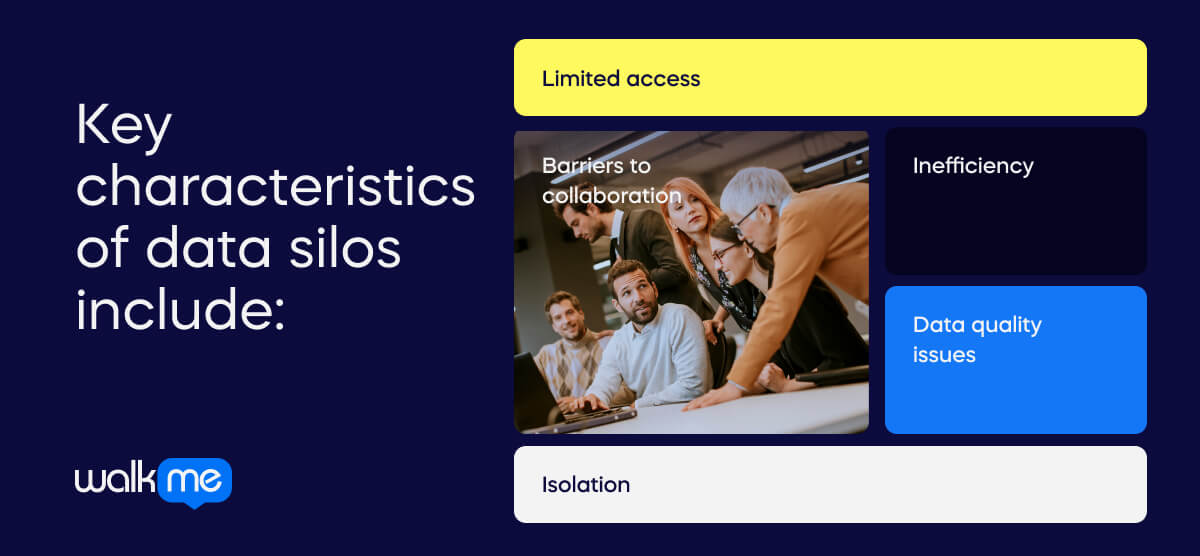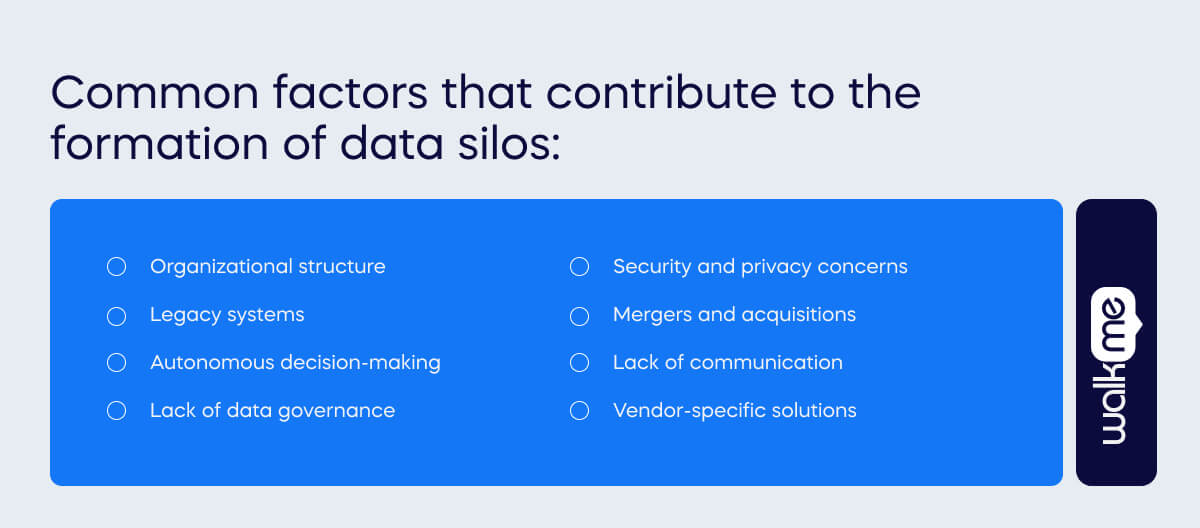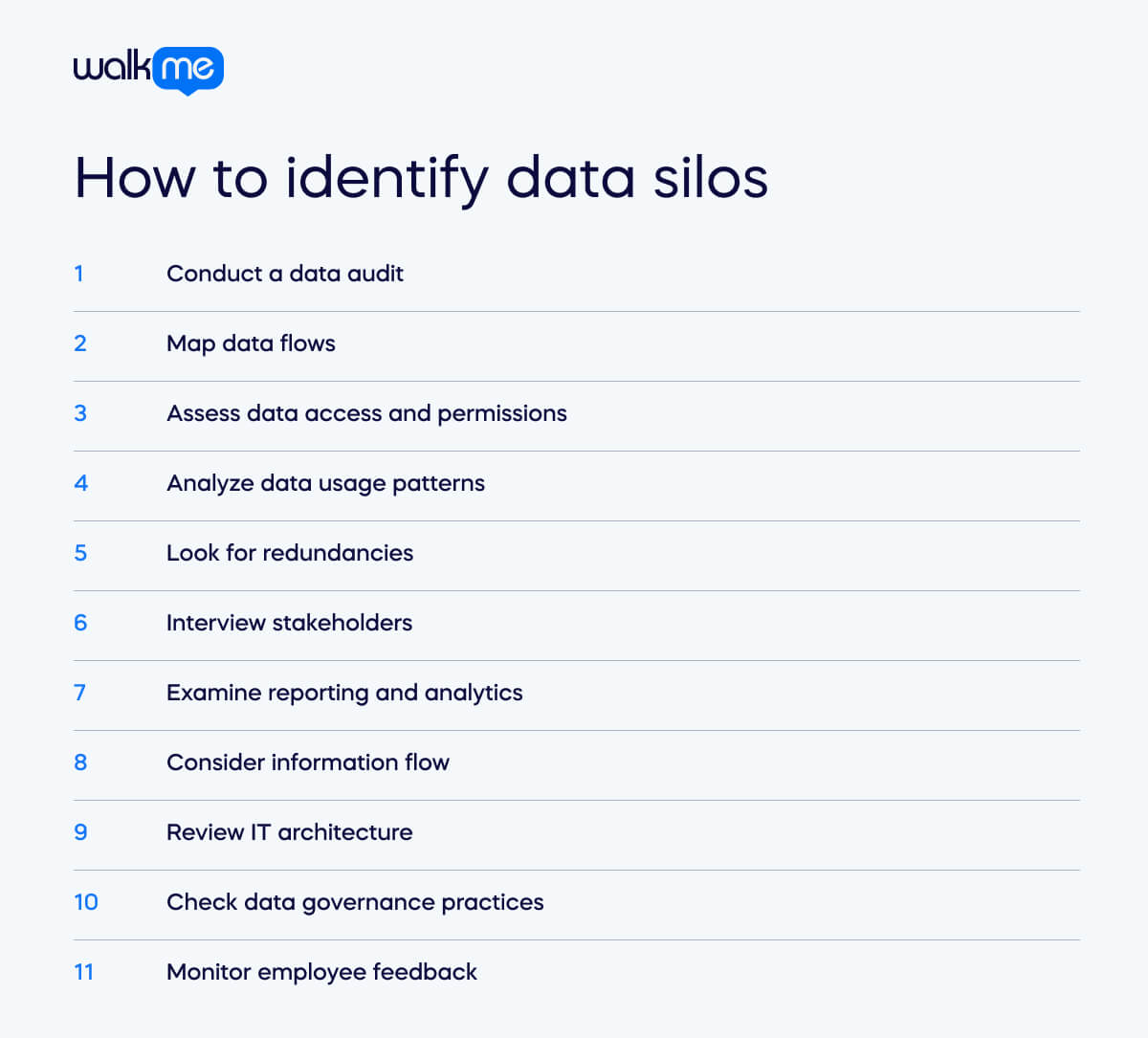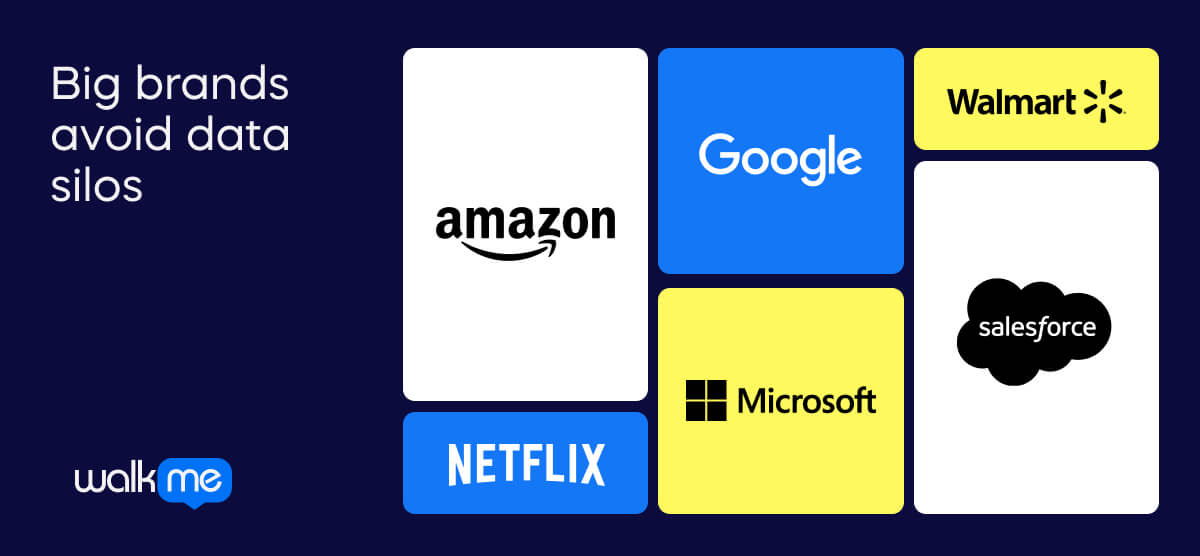What are data silos?
Data silos refer to situations where data is stored or managed in isolated and separate systems within an organization.

Table of contents
In other words, different departments or teams may have their own databases, software applications, or data storage solutions that are not easily accessible or integrated with those of other departments.
As a result, information becomes compartmentalized, and there is limited sharing and collaboration between different parts of the organization.
Breaking down data silos is often a priority for organizations aiming to improve data ecosystem management, enhance collaboration, and make more informed and strategic decisions.
Integration tools, data governance policies, and a cultural shift toward promoting data sharing and collaboration are some of the strategies organizations use to address data silos.

Key characteristics of data silos include:
Isolation
Data is kept in separate databases or systems, often maintained by different teams or departments.
Limited access
Access to data in one silo may be restricted, making it challenging for other parts of the organization to retrieve or utilize that information.
Inefficiency
The lack of integration and sharing can lead to inefficiencies, duplication of efforts, and difficulty in obtaining a comprehensive view of the organization’s data.
Research from Forrester and Airtable reveals that data silos take up 2.4 hours of an employee’s average working day, greatly hindering productivity levels.
Data quality issues
Maintaining consistency and accuracy of data becomes challenging when it is stored in isolated silos, as updates or changes may not be uniformly applied across all systems.
Barriers to collaboration
Data silos can create barriers to collaboration between different teams or departments, as information is not easily shared or accessible across the organization.
How are data silos formed?
Data silos can form within organizations for various reasons, often as a result of historical, organizational, or technological factors.

Here are some common factors that contribute to the formation of data silos:
Organizational structure
When an organization is structured to promote strong departmental boundaries, each department may have its own set of processes, tools, and systems.
This can lead to the creation of data silos, as data is managed independently within each department.
Legacy systems
Organizations using legacy systems or older technologies may struggle to integrate these systems with newer ones.
As a result, data might be stored and managed in separate systems, leading to silos.
Autonomous decision-making
Departments or teams might make decisions about data management independently without considering the broader organizational context.
This autonomous decision-making can lead to the adoption of disparate tools and systems.
Lack of data governance
Different departments may use different data formats, naming conventions, and quality standards without proper data governance policies and standards.
This lack of standardization contributes to the formation of data silos.
Security and privacy concerns
Concerns about data security and privacy may lead to a situation where access to data is restricted.
While this is important for sensitive information, it can inadvertently contribute to the creation of data silos.
Mergers and acquisitions
In cases of mergers or acquisitions, organizations may inherit different systems and databases.
Integrating these diverse systems can be complex, and as a result, data silos may persist until a comprehensive integration strategy is implemented.
Lack of communication
Insufficient communication between departments or teams can contribute to the development of data silos.
When there is a lack of awareness about the importance of data sharing and collaboration, silos are more likely to form.
Vendor-specific solutions
Organizations heavily dependent on specific vendors may face integration challenges, hindering collaboration.
Vendor-specific technologies often result in isolated data ecosystems, limiting interoperability.
How do data silos negatively impact a business?
Data silos can have several negative impacts on a business, affecting its efficiency, decision-making, and overall performance.
Here are some common ways in which data silos can negatively impact a business:
Reduced collaboration
Data silos create barriers between different departments or teams, limiting collaboration and hindering the sharing of information.
This can lead to missed opportunities for innovation and improvement.
Inefficient decision-making
Decision-makers may not have access to a comprehensive view of the organization’s data, leading to incomplete or inaccurate insights.
Inefficient decision-making can result from the lack of a unified and integrated data source.
Duplication of efforts
Different departments or teams may independently collect and maintain similar data, leading to duplication of efforts.
This redundancy wastes resources and introduces the potential for inconsistencies and errors.
Increased costs
Over time, the cost of integrating disparate systems and overcoming data silos can become significant.
Businesses may incur expenses related to system integration, data migration, and adopting new technologies.
According to IDC research, data management comprises the largest percentage of IT infrastructure spending.
Customer dissatisfaction
Data silos can result in inconsistencies in customer data, leading to a fragmented and disjointed customer experience.
This adversely affects customer satisfaction and loyalty over time.
Slower response to market changes
Businesses with data silos may struggle to respond quickly to market changes or evolving customer needs.
The inability to access and analyze real-time data can hinder agility and competitiveness.
Data quality issues
Data stored in isolated silos may suffer from quality issues such as inaccuracies, outdated information, or inconsistencies.
Poor data quality can undermine the reliability of business analytics and reporting.
Compliance risks
Data silos can make it challenging to maintain and demonstrate compliance with regulations, especially when data is spread across multiple systems.
This can expose the business to legal and regulatory risks.
Limited innovation
Collaboration and cross-functional team communication is essential for innovation.
Data silos hinder the flow of information and ideas, limiting the organization’s ability to innovate and adapt to changing market conditions.
Employee frustration
Employees may face frustrations and inefficiencies in their daily workflows due to navigating multiple systems and data sources.
This can lead to decreased morale and less employee productivity.
How to identify data silos

Identifying data silos within an organization requires a systematic approach that involves examining various aspects of data management, communication, and collaboration.
Here are several steps and considerations to help identify data silos:
Conduct a data audit
Create a comprehensive inventory of all data sources within the organization.
This includes databases, spreadsheets, applications, and other repositories where data is stored.
Map data flows
Understand how data flows within the organization. Identify the paths data takes from creation or acquisition through storage, processing, and analysis.
This mapping helps reveal any bottlenecks or points of isolation.
Assess data access and permissions
Examine access controls and permissions for different data sources.
Determine who has access to what data and whether access is restricted, contributing to isolation.
Analyze data usage patterns
Look into how different departments or teams use data.
Identify data usage patterns and whether certain data sets are confined to specific areas of the organization.
Look for redundancies
Check for redundant or duplicated data across different systems.
If multiple departments are independently maintaining similar datasets, it may indicate the presence of data silos.
Interview stakeholders
Conduct interviews with key stakeholders from different departments.
Ask about their data needs, sources of information, and any challenges they face in accessing or sharing data.
Examine reporting and analytics
Analyze the tools and systems used for reporting and analytics.
If different departments use separate tools or generate inconsistent reports, it may indicate data silos.
Consider information flow
Examine how information flows within the organization.
Identify communication channels and assess whether there are gaps in information sharing.
Review IT architecture
Understand the organization’s IT architecture.
Assess whether systems are designed to work together or if they operate independently, contributing to data isolation.
Check data governance practices
Review the organization’s data governance practices.
Assess whether there are established standards for data management, quality, and sharing.
Monitor employee feedback
Solicit feedback from employees regarding their experiences with data access and collaboration.
Employee insights can provide valuable information about potential data silos.
How to break down and prevent data silos
Breaking down existing data silos is a challenging but essential task for organizations aiming to improve collaboration, data integration, and decision-making.
Once this job is complete, preventing the formation of new data silos in the future is crucial.
A proactive approach is required, encompassing effective organizational policies, communication strategies, and technology solutions.
According to Gartner, more than 50% of enterprise-critical data will be created and managed outside of centralized systems such as data centers or the cloud by 2025.
This highlights the need for organizations to prioritize avoiding data silos from occurring regularly.
Here are several strategies to help break down and prevent data silos:
Establish a data governance framework
Develop and implement a robust data governance framework that includes policies, standards, and procedures for data management.
Ensure that there are data quality, security, and sharing guidelines across the organization.
Define data ownership and responsibilities
Clearly define data ownership and responsibilities for different data sets.
Assign specific individuals or teams accountable to ensure data is managed, updated, and shared appropriately.
Promote a culture of collaboration
Foster a culture that values collaboration and information sharing.
Encourage open communication between departments and teams, emphasizing the importance of working together to achieve common goals.
Invest in integrated systems
Implement integrated information systems that allow for seamless data flow between different departments.
Choose platforms and tools that support interoperability and enable real-time data sharing.
Conduct data integration projects
Initiate data integration projects to bring together data from disparate sources.
Implement technologies and solutions that facilitate the smooth data exchange between systems, ensuring consistency and accuracy.
Standardize data formats and definitions
Establish standardized data formats, naming conventions, and definitions across the organization.
Consistency in how data is represented enhances interoperability and reduces confusion.
Implement master data management (MDM)
Deploy master data management solutions to centralize and manage critical data, such as customer information or product data.
MDM helps maintain a single, authoritative source for key data elements.
Enable cross-functional teams
Encourage forming cross-functional teams that involve members from different departments working together on projects.
This facilitates collaboration and ensures that diverse perspectives are considered.
Provide training and education
Offer training programs to employees on the importance of data sharing, collaboration tools, and best practices.
Ensure that staff members are well-equipped to navigate integrated systems and understand the benefits of breaking down silos.
Use cloud-based collaboration tools
Implement cloud-based collaboration tools that enable real-time sharing and collaboration on documents and data.
Cloud-native platforms often provide centralized storage and access, reducing the need for isolated data repositories.
Establish clear communication channels
Set up clear communication channels for sharing information across departments.
Regular meetings, newsletters, and collaborative platforms can facilitate communication and ensure that relevant information is disseminated.
Monitor and evaluate progress
Establish key performance indicators (KPIs) to measure progress in breaking down data silos.
Regularly evaluate the success of integration initiatives and adjust strategies as needed.
Address security and privacy concerns
Implement security measures to protect sensitive data while allowing appropriate access and sharing.
Ensure that data privacy regulations are adhered to during integration efforts.
Seek executive support
Obtain support from top leadership to endorse and champion efforts to break down data silos.
Leadership commitment is crucial for driving cultural and structural changes within the organization.
Data silos vs information silos
Sometimes, people can get the terms ‘data silo’ and ‘information silo’ mixed up or use them interchangeably.
While these are related concepts, they are not exactly the same.
Both refer to situations where data or information is isolated or compartmentalized within an organization, hindering its efficient use and sharing.
However, it’s important to know how the two terms differ.
Here’s a breakdown:
| Data silos | Information silos |
| Data is stored in separate and isolated databases or systems within an organization. | A broader concept, not just limited to data. Relevant information is compartmentalized or isolated within different parts of an organization. |
| Different departments or teams may maintain their own databases, which may not be easily accessible or integrated. | One department might have valuable insights or expertise not effectively communicated or shared with other departments. |
| Limited sharing and collaboration when it comes to accessing and utilizing data. | Inefficiencies and missed opportunities when it comes to sharing information. |
In summary, data silos specifically focus on the isolation of data within an organization, while information silos encompass a wider range of isolated information, including data, knowledge, and expertise.
Both concepts highlight collaboration, communication, and efficiency challenges within an organization.
Breaking down these silos is often a goal for organizations seeking to improve overall productivity and decision-making.
How big brands avoid data silos
Many big brands have implemented strategies to prevent or break down data silos, recognizing the importance of integrated and collaborative data management.

Here are examples of how some large organizations have addressed data silos:
Microsoft
Microsoft’s Azure data share is a service designed to facilitate secure data sharing across organizational boundaries.
It enables organizations to share data in real-time with external partners or internal departments, breaking down traditional data silos.
Amazon
Amazon Web Services (AWS) offers data exchange, a platform that allows organizations to find, subscribe to, and use third-party data.
AWS data exchange helps in breaking down data silos by providing a centralized marketplace for data sharing.
Google Cloud’s BigQuery is a fully managed, serverless data warehouse that enables organizations to analyze large datasets.
With tools like Data Studio for visualization, Google provides an integrated ecosystem supporting collaborative and integrated data analysis.
Salesforce
Salesforce’s customer platform is designed to provide a unified view of customer data across different Salesforce applications.
It helps organizations break down data silos related to customer information by centralizing and connecting customer data.
Walmart
Walmart is known for its advanced supply chain management systems that integrate data from suppliers, distribution centers, and retail stores.
This integration helps prevent data silos and enables real-time decision-making for inventory management.
Netflix
Netflix has adopted a data mesh architecture, a decentralized approach to data ownership and architecture.
It breaks down data silos by promoting domain-oriented decentralized data ownership and access.
How to roll out data integration strategy in the workplace
Rolling out a data integration strategy for a company involves careful planning, coordination, and communication.
Here is a step-by-step guide to help you implement a successful data integration strategy:
Define objectives and goals
Clearly articulate the objectives and goals of the data integration strategy.
Understand the specific business outcomes you aim to achieve, such as improved decision-making, increased operational efficiency, or enhanced customer experiences.
Conduct a data assessment
Perform a comprehensive assessment of existing data sources, systems, and processes. Identify data silos, data quality issues, and integration challenges.
This assessment will serve as a foundation for developing your integration plan.
Establish a data governance framework
Develop and implement a robust data governance framework that includes policies, standards, and procedures for data management.
Clearly define data ownership, quality standards, and access controls.
Form a cross-functional integration team
Assemble a cross-functional team that includes representatives from IT, data management, business units, and other relevant stakeholders.
This team will be responsible for driving the implementation of the data integration strategy.
Select integration technologies
Choose appropriate integration technologies and tools based on your company’s needs and existing infrastructure.
This may include data integration platforms, middleware, APIs, and cloud-based solutions.
Prioritize data integration initiatives
Allocate priorities based on what is most important to the business, critical data sets, and areas where integration can deliver the most significant impact.
Start with manageable projects before scaling to more complex integrations.
Implement master data management (MDM)
If applicable, implement master data management solutions to establish a single, authoritative source for critical data elements.
MDM helps maintain data consistency across the organization.
Develop integration roadmap
Create a phased integration roadmap outlining the sequence of integration initiatives, milestones, and timelines.
Communicate the plan to all stakeholders and ensure alignment with business objectives.
Provide training and education
Offer training programs to employees on the new data integration processes, tools, and standards.
Ensure that staff members are familiar with the changes and understand the benefits of the integration strategy.
Deploy integration solutions
Begin implementing integration solutions based on the prioritized roadmap.
Test and validate the integrations to ensure data accuracy, security, and performance. Address any issues promptly during the deployment phase.
Monitor and optimize
Implement monitoring and optimization mechanisms to track the performance of integrated systems.
Use key performance indicators (KPIs) to measure the success of integration initiatives and continuously refine the strategy based on feedback and results.
Facilitate change management
Implement a change management plan to address any cultural shifts or resistance associated with the new data integration strategy.
Communicate the benefits of integration and how it aligns with the company’s overall goals.
Ensure security and compliance
Implement security measures to protect sensitive data during integration.
Ensure compliance with data protection regulations and industry standards. This includes encryption, access controls, and auditing mechanisms.
Promote a culture of collaboration
Foster a culture that values collaboration and data sharing.
Encourage open communication between departments and teams, emphasizing the importance of working together to achieve common goals.
Evaluate and scale
Regularly evaluate the success of integration initiatives against predefined goals. Identify areas for improvement and scalability.
Use lessons learned to inform future integration projects and scale the strategy as needed.